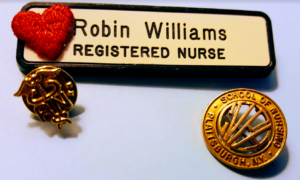Nursing Informatics Series: Robin’s Journey
Growing up, my role models were family friends who were registered nurses. They were compassionate and confident. I wanted to be like them. After graduating nursing school, I went to work in surgical ICU. Looking back now, I realize I have always relied on and have learned to trust technology even when it was electronic devices connected to my ICU patients.

Graduate of Champlain Valley Physicians Hospital School of Nursing.
In the first 19 years of my career when I was an ICU nurse, physician office nurse, and home care nurse, computers were used by the laboratories and billing departments, but computers were not anything I ever thought of using for “charting” my nursing notes. I shake my head when I think about the handwritten index cards used for administering medication, or the number of times I spoke to patients or other healthcare professionals without having access to the patient’s medical record. Sometimes just locating medical records was challenging, and even when they were available, the records were often incomplete due to a backlog of paper forms and unfiled lab results.
In the early 1990s, the home care agency where I worked implemented a computerized patient record. Though the terminology associated with computer software and hardware was foreign to me, I quickly realized the advantages. I didn’t have to keep track of patient information in my head or on my paper cheat sheets anymore. I just needed to learn how to use this new tool that made the patient medical record easily accessible. The IT person responsible for implementation had no clinical background and could not help the nurses use the software to document clinical notes. I did a lot of trial and error to learn on my own; I wasn’t afraid to touch icons, look at lists, or to explore the application looking for ways to document efficiently. I also wanted to understand how the data I entered was presented on reports and what reports were available. I became the go-to person for the nursing and technical staff, eventually creating a nurse informaticist position for myself. In this new role, I completed the electronic health record (EHR) roll-out across all clinical disciplines (nursing, rehab, respiratory therapy, and social services). I also started interacting with the technology vendor, providing clinical insight and real-world examples needed to make the software more clinically relevant and usable.

Clinical analyst at Lantana.
In my role as a nurse informaticist, I found myself moving away from teaching and interpreting medical details for patients to interpreting them for the EHR vendor. Within a few years, I was working for the vendor as a clinical analyst in research and development. For 17 years, I helped develop software tools for clinicians to use. I focused on the development of clinical tools for quality management and quality reporting including clinical decision support and population health management.
Regulations, standards, and policies govern patient care and the development and implementation of clinical tools. Since joining Lantana in 2015, I have influenced regulations, standards, and policies by working on projects to develop clinical decision support artifacts, develop and test clinical quality measures and electronic clinical quality measures, and to deploy them in different care settings. I have performed quantitative and qualitative analyses to assess the feasibility and reliability of data collection tools and quality measure reporting. I assist with rule making and standards development that advance interoperability and sharing of clinical information. In all my projects, my focus is on the real-world applications, assessing the impact regulations, standards, and policies have on patient care and the healthcare professionals who provide it.
Nurses are leaders in informatics, shaping the future of healthcare. My 40-year journey has been a great adventure, and I am not done yet!
